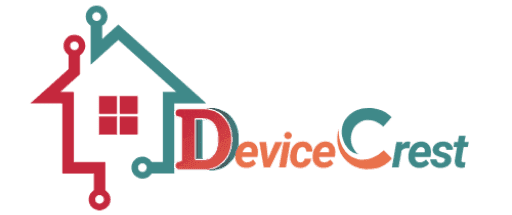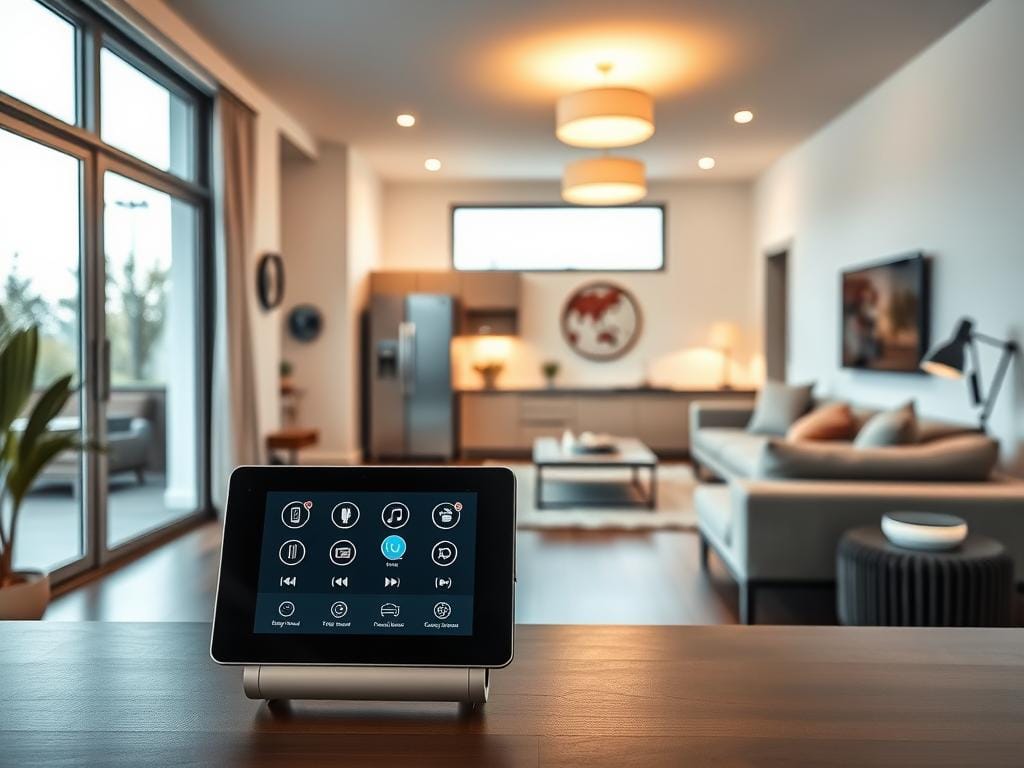Imagine making your home better with just a button or voice command. Home automation technology is changing how we live, with 30% of homes using smart devices in 2023.
Smart homes are becoming a reality, not just a dream. The market is growing fast, expected to hit $174 billion by 2025. This shows how connected devices can make our lives easier.
From smart thermostats to voice assistants, home automation brings convenience. It changes how we live, making our homes smarter and more efficient.
Homeowners are seeing the big difference. 67% say smart tech makes their lives easier, and 80% feel safer. It’s becoming a must-have, not just a nice-to-have.
Key Takeaways
- 30% of US households now use smart home devices
- Global smart home market expected to reach $174 billion by 2025
- 67% of homeowners find smart technology simplifies routines
- Smart devices offer enhanced home security and convenience
- Voice control and remote management are driving technology adoption
Understanding Modern Home Automation Technology
Home automation has changed how we live. The internet of things has made our homes smarter. Now, our homes can respond to us in new ways.
What Defines a Smart Home System
A smart home system links appliances and devices for better home use. You can control these elements with apps or voice commands. This makes life easier and more convenient.
- Integrated device communication
- Centralized control mechanisms
- Automated decision-making capabilities
Core Components of Home Automation
Home automation uses key technologies to make our homes smart:
| Component | Function | Example Devices |
|---|---|---|
| Smart Hubs | Central communication point | Amazon Echo, Google Home |
| Sensors | Data collection and environment monitoring | Motion detectors, temperature sensors |
| Actuators | Physical device control | Smart locks, motorized blinds |
How Smart Home Networks Function
Smart home networks use interconnected devices to talk wirelessly. They share data in real-time. This lets homeowners control their homes from anywhere.
By 2025, over 55% of U.S. households are expected to adopt smart home technologies, demonstrating the growing significance of home automation.
The internet of things is making our homes smarter. It’s making our homes more efficient and easy to use.
The Evolution of Smart Home Solutions

Home automation technology has changed a lot over the years. It started in the mid-20th century and has grown into today’s smart home systems. The first smart home device was made in 1966. It could make shopping lists and control the temperature inside.
The journey of smart home solutions has many interesting points:
- 1970s: X10 protocol enabled device communication
- 1980s-1990s: Focus on assistive technologies for senior care
- Early 2000s: First complete smart home demonstrations
- 2010s: Introduction of intelligent voice assistants
Artificial intelligence has played a big role in this change. By 2025, the smart home market is expected to hit $174 billion. Over 70% of U.S. households will have at least one smart home device. This shows how homes are becoming more integrated and intelligent.
Today’s smart home tech offers a lot of convenience and efficiency. Devices talk to each other, learn what we like, and make our homes better. Voice controls and apps have changed how we live, making smart homes a key part of modern life.
Smart homes are no longer a luxury—they’re becoming the new standard in residential technology.
As artificial intelligence gets better, we’ll see even smarter homes. These homes will understand us better and make our lives easier.
Benefits of Integrating Smart Home Systems

Smart home technology has changed how we live. It connects devices and systems in our homes. This brings us convenience, efficiency, and security.
- Enhanced daily convenience through automated tasks
- Significant energy management solutions
- Advanced home security integration
- Cost-effective technology implementation
Enhanced Daily Convenience
Smart home tech makes daily tasks easier. Automated lighting control lets you change lights with apps or voice commands. This cuts down on manual work.
Energy Management and Cost Savings
| Smart Technology | Annual Energy Savings | Cost Reduction |
|---|---|---|
| Smart Thermostats | 10-12% | $150-$180 |
| Smart Lighting | 10-30% | $100-$300 |
| Overall System | Up to 30% | $300-$500 |
Improved Home Security Features
Modern home security systems offer top-notch protection. They use smart cameras, motion sensors, and locks. These can be watched from anywhere, giving homeowners peace of mind.
Smart home technology transforms living spaces into intelligent, responsive environments that adapt to resident needs.
Investing in smart home systems costs from $100 for devices to $15,000 for full automation. With the market growing, these technologies are a smart choice for modern living.
Essential Smart Home Devices and Applications
Smart home systems have changed how we live. They bring convenience and control to our homes. With 75% of users controlling devices with their voice, they’re a big part of our lives.
Let’s look at the key smart home devices changing our homes:
- Smart Hubs and Controllers: Central management systems for connected devices
- Automated Lighting Control: Energy-efficient illumination solutions
- Smart Security Systems: Advanced protection technologies
- Voice-Activated Assistants: Intelligent home interaction platforms
The global smart home market is expected to hit $174 billion by 2025. This shows how fast it’s growing. Homeowners can use smart systems to save energy, improve security, and more.
- Reduce energy consumption by up to 30%
- Enhance home security with integrated monitoring
- Create personalized environment controls
- Streamline daily household management
Devices like smart thermostats and security cameras are getting smarter. With 70% of devices supporting the Matter standard, homes are becoming more connected.
As tech keeps improving, smart homes will get even easier to use. They’ll bring more convenience and efficiency to our homes.
Voice Control and AI Integration in Home Automation

Voice control technology has changed how we live. Artificial intelligence assistants make home automation a part of our daily lives. By 2023, about 50% of city homes will use smart technology, showing how fast voice control is becoming common.
Voice control assistants do more than just take commands. They make our homes better in many ways:
- 70% find voice control more convenient than traditional interfaces
- 95% voice recognition accuracy in ideal conditions
- Hands-free operation for improved accessibility
Popular Voice Assistant Platforms
Top voice assistant platforms have changed home automation. Amazon Alexa, Google Assistant, and Apple’s Siri are now key for smart homes. They let users control lights, security, and more with voice commands.
“Voice control is not just a technology trend, it’s a lifestyle transformation.” – Tech Innovation Quarterly
Artificial Intelligence in Smart Homes
AI in home automation does more than just take voice commands. It learns what we like, saves energy, and makes our homes just right. AI can cut energy use by up to 30% by smartly managing our homes.
Voice-Activated Device Management
Today’s voice control devices make managing our homes easy. We can control everything from thermostats to security with just our voice. This makes home management simple and efficient.
As tech keeps getting better, voice control and AI will be even more important in our homes.
Smart Home Security and Privacy Features

Modern home security has evolved dramatically, thanks to connected devices that enhance safety and provide greater peace of mind. Traditional security methods are quickly becoming outdated as smart home systems introduce cutting-edge technology.
Key features of smart home security include:
- Advanced motion sensors that send instant alerts to your smartphone
- High-resolution night vision cameras for 24/7 monitoring
- Smart locks with remote access control
- Integrated alarm systems that trigger emergency notifications in real time
As smart home technology advances, security remains a top concern. Shockingly, around 70% of IoT devices have vulnerabilities, making strong protection measures essential. Implementing multi-factor authentication can reduce unauthorized access by up to 99.9%, reinforcing digital safety for modern homes.
Privacy is a big worry for people using smart home tech. 85% of users are concerned about their data. To keep their info safe, homeowners should:
- Keep device firmware up to date
- Use strong, unique passwords
- Turn on multi-factor authentication
- Check privacy settings often
The smart home security market is growing fast. It’s expected to hit $74.75 billion by 2025. By picking and setting up connected devices wisely, homeowners can build strong security networks. These networks protect both our homes and our digital lives.
Energy Management Through Home Automation Technology
Smart home systems are changing how we manage energy at home. They use advanced tech to help us use energy more efficiently.
Today’s energy management tools are smarter than ever. They help cut down on electricity bills and protect the environment. The U.S. Department of Energy says smart thermostats can save up to 10% on heating and cooling costs each year.
Smart Thermostats and Climate Control
Smart thermostats are a big step forward in saving energy. They don’t just control the temperature. They also learn your habits and adjust settings for you.
- Geofencing technology detects when you’re away and adjusts temperature automatically
- Advanced sensors track occupancy and optimize heating/cooling
- Remote control through smartphone apps allows real-time adjustments
Automated Lighting Solutions
Smart lighting is key to saving energy. LED bulbs and smart lighting systems can greatly reduce electricity use.
- Motion sensors automatically turn lights on and off
- Daylight sensing adjusts brightness based on natural light
- Programmable schedules prevent wasted electricity
“Smart home technology transforms energy management from a complex challenge into an effortless experience.” – Tech Innovation Magazine
Energy Consumption Monitoring
Monitoring energy use in real-time gives homeowners valuable insights. These systems track how much each appliance uses. This helps find ways to use even less energy.
With smart home tech, homes can save 10-20% on energy costs. The cost of these systems is often paid back through savings and better efficiency.
Remote Access and Mobile Control Capabilities
Smart home systems have changed how we interact with our homes. They offer powerful remote access. Now, homeowners can control their homes from anywhere using smartphones or tablets.
The main benefits of remote access in smart homes are:
- Real-time device monitoring and control
- Enhanced home security management
- Energy efficiency optimization
- Convenient lifestyle management
Thanks to new tech, remote access is now common. Homeowners can lock doors, adjust thermostats, view security cameras, and manage lighting with just a few taps on their mobile devices. This makes life easier and safer.
Remote access tech offers many features, including:
- Instant device status updates
- Automated scene creation
- Emergency notifications
- Customizable device interactions
Security is a big deal. Two-factor authentication and secure networks keep remote access safe from hackers. With 75% of users saying it’s more convenient, smart homes are changing how we live.
The future of home management is now in the palm of your hand.
Conclusion
Our exploration of smart home systems shows a big change in technology. It’s not just about making things easier. Home automation has grown into a network of devices that meet our daily needs. It’s making our homes smarter and more responsive.
The demand for smart home devices is growing fast. Experts say it will grow by 25% each year from 2023 to 2030. Homeowners are enjoying better security, saving energy, and more control over their homes. Smart devices are changing how we live.
New technologies like 5G and AI will make home automation even better. We’ll see systems that work together better, are easier to use, and more intuitive. For those wanting a better life, more value, and efficiency, smart homes are essential.
As tech gets better, our homes will become more like smart friends. They’ll understand and adjust to our lives. The future of homes is exciting, with possibilities that are truly intelligent.
The Best Robots for Kids – Fun, Learning & STEM Skills! 🤖✨
Looking for the perfect robot for kids that’s both fun and educational? Whether it’s for coding, creativity, or just playtime, we’ve rounded up the best interactive robots to spark curiosity and develop essential STEM skills!
🔥 In This Guide, You’ll Discover:
✔️ Top-rated robots for learning & entertainment
✔️ How programmable robots teach coding & problem-solving
✔️ Key features to consider: durability, ease of use & interactivity👉 Check out the full guide to find the perfect robot for your child!
🔗 Read more here!Unlock creativity and inspire the next generation of innovators! 🚀🔧
https://devicecrest.com/blog/guides/robot-for-kids/



1 thought on “Home Automation Technology: Simplify and Enhance Your Life”